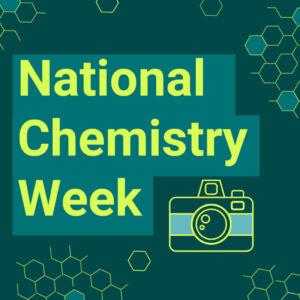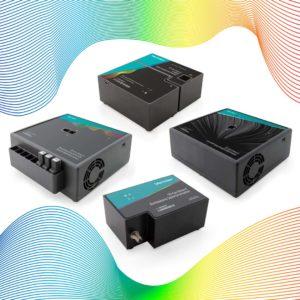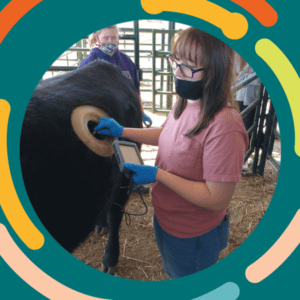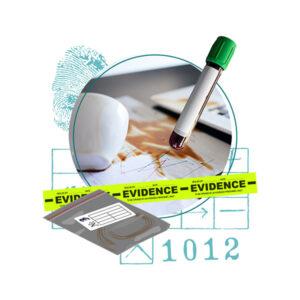
Sharing ideas and inspiration for engagement, inclusion, and excellence in STEM
Our Top Blog Posts of 2024
Wow, 2024 has been an unforgettable year! From launching our inaugural Vernier Trendsetters Community cohort and witnessing a total solar eclipse alongside educators across the path of totality, to welcoming Jill Hedrick as our new CEO, we’ve celebrated many milestones. This year also saw the release of exciting new tools, including the Cart Fan, Go Direct® Force Plate, Go Direct Salinity Sensor, and Go Direct Soil Moisture Sensor!
Why Teach the Melting Point of Organic Compounds?
At my school Archbishop Hoban High School in Akron, Ohio, I teach a semester of organic chemistry as an advanced science elective. Students who choose this course learn about carbon-based compounds, from alkanes to arenes, and use a range of Vernier instruments, from melt stations to mini gas chromatographs. Taking this class not only gives my students more opportunities to hone their lab skills, but it also helps them to develop their understanding of organic compound behavior and physical properties of matter.
One key concept we explore in this class is the melting points of organic compounds. This lesson can easily fit within a chemistry unit on covalent compounds or intermolecular forces—it’s also a valuable lesson to include in AP chemistry courses when covering the properties of substances and mixtures (Unit 3). Investigating this physical property can help students understand how materials are characterized by measurable properties, how molecular forces influence those properties, and why materials with different properties are better suited to different practical uses. In particular, melting points are useful for making predictions about the purity of a substance and about the identification of an unknown compound.Three Picture Perfect Experiments to Celebrate National Chemistry Week
Get ready for National Chemistry Week with Vernier! This year, the American Chemical Society (ACS) is celebrating the chemistry behind photography and imaging. From traditional film cameras to cutting-edge medical imaging technologies, chemistry plays a critical role in capturing, creating, and revealing the visuals that shape how we experience the world.
From Summer Science Camps to Teacher Training: Dr. Ann Nalley Shares Why Vernier Technology Is the Future of STEM Education
Dr. Ann Nalley, a chemistry professor at Cameron University in Oklahoma and former president of the American Chemical Society (ACS), has dedicated her career to empowering both students and teachers through hands-on science education. With more than 50 years of experience teaching freshman and organic chemistry, leading summer academies for K–12 students, and training teachers at the university and through workshops, she has become a passionate advocate for integrating Vernier technology into classrooms and labs.
Four Laws, One Sensor: Introducing Students to Gas Laws Using the Go Direct Gas Pressure Sensor
Understanding how gases behave under different conditions is not just crucial for chemistry class—it is knowledge that applies to many real-world situations, from predicting weather patterns to optimizing car engines. As the new school year begins, it’s the perfect time to introduce students to—or refresh their understanding of—the four fundamental gas laws: Boyle's law, Gay‑Lussac's law, Charles' law, and Avogadro's law. Teaching about these laws not only helps students understand the relationship among gases’ different properties, but also helps them develop the fundamental knowledge needed to progress into more advanced chemistry concepts, such as thermodynamics and kinetics, later in the school year.
Where Math Meets Science: Connecting Vernier Go Direct Sensors and TI-Nspire Technology
Looking for ways to make math more accessible to your students? Help them build confidence in math and science concepts by using real-time data collection! When students are tasked with exploring real-world phenomena, math transforms from an abstract, intimidating concept into a practical tool that students can use to develop and articulate answers to questions like, “Why are headlights on a car dimmer at a distance?” or “Why do I feel warmer wearing a black shirt on a sunny day?”
With enhanced compatibility between Vernier and Texas Instruments, students can now explore math in tangible, real-world scenarios by wirelessly capturing and analyzing real-time data on their TI-Nspire™ CX II graphing calculators. By integrating math and science, educators can enrich student comprehension, deepen their understanding of the natural world, and prepare students for careers in STEM.How to Introduce Your Students to Data-Collection Basics
Whether studying CO2 changes during photosynthesis or investigating the conservation of momentum during a collision, students need to be able to do more than just plot points on a graph—they need to understand the story that a graph tells. One incredibly effective way to develop this kind of data literacy is to incorporate data-collection technology and investigations into your instruction. Real-time data collection not only helps students build stronger connections between abstract scientific concepts and the real world but also helps students transform raw data into meaningful insights through tabulation, graphs, visualization, and statistical analysis.
Choosing the Right pH Sensor for Your Classroom or Lab
From testing household acids and bases to evaluating soil and water quality for agriculture, measuring and interpreting pH data is an essential skill across scientific disciplines and education levels. Our pH sensors all offer similar accuracy, response time, and sensitivity. So, which one should you buy? It depends on how and where you plan to use your pH sensor. Follow these guidelines to help you choose the right tool for your specific lab or classroom needs.
Investigating Ions: Three Chemistry Experiments with the Go Direct Conductivity Probe
Students are often a little shocked to learn that water is actually a poor conductor of electricity. So, why the caution with electronics near water? This is because water can dissolve ionic compounds into individual ions that carry electric charges—electrolytes. Measuring a solution’s conductivity tells us about its ionic content and its electrical conductivity, and investigating this phenomena can help students develop a stronger understanding of the structure and properties of matter and chemical reactions. The Go Direct® Conductivity Probe, with its wide range of 0 to 20,000 μS/cm and alternating current that improves sensor longevity, is an excellent tool for deepening student understanding of many fundamental chemistry concepts, from ionic bonding to chemical titrations. Here are three investigations to help you get started.
Five Trailblazing Female Asian American & Pacific Islander Scientists with Impactful STEM Legacies
May is National Asian American and Pacific Islander Heritage Month, an excellent time to help your students learn about the pivotal contributions Asian Americans, Native Hawaiians, and Pacific Islanders have made to the STEM fields—and continue to make today! As we celebrate their accomplishments, it’s also important to acknowledge the gaps in visibility within these groups, particularly among AAPI women in science. For example, recent studies have shown women in this demographic are notably less likely to be employed in leadership positions in STEM, even when highly educated. This discrepancy also persists in educational resources, where textbooks continue to underrepresent women and people of color in STEM. To help spotlight their considerable academic and scientific research contributions, here are five influential AAPI women whose stories and achievements you can share with your students, as well as a few experiment ideas to connect with their research.
An Experiment to Help Students Understand Ocean Acidification through pH
Today’s environmental challenges call for ongoing discussions and hands-on learning opportunities to deepen student understanding and engagement in environmental stewardship. One such activity is to investigate how the burning of fossil fuels not only contributes to climate change, but also leads to changes in environmental chemistry, such as the increase in ocean acidification and subsequent increase in acid rain.
Ready, Set, Science! Get Your Science Game On with These Four Sports‑Themed Experiments
We had such a blast at NSTA Denver 2024 last week! One of our big highlights this year was getting to mix science and sports with fun, athletics-inspired activities. Below we’re sharing four of our favorite sports-themed experiments you can try out to elevate your classroom game!
Top Three Topics That Students Miss in AP Chemistry Prep and How to Tackle Them
As the AP Exam* season approaches, now is a great time to revisit relevant topics that may have been overlooked during your exam preparation. Certain topics, especially those in electrochemistry, thermodynamics, and kinetics, tend to get missed either because they appear late in the curriculum, leaving little time for thorough coverage, or because their complexity can be daunting, leading some educators to skirt around them. In this blog post, we’re sharing some practical experiments from our lab books that can help you address potential gaps.
Transform Your Chemistry Class into a Forensic Lab with our Newest Lab Book
Looking for a way to make chemistry class more exciting for your students? One approach is to use fictitious crimes to provide real-world learning opportunities at the crossroads of chemistry fundamentals and crime scene analysis.
Exploring Light through Spectroscopy: Two Engaging Experiments for Chemistry Classes
While Beer’s law might be the most common experiment that comes to mind when thinking about spectrometers, spectroscopy is fundamental throughout the first year of chemistry! And because it’s such a powerful tool for teaching chemistry fundamentals, it’s important in nearly every level of chemistry onwards. There are many hands-on activities your students can do with spectrometers, such as the Go Direct® SpectroVis® Plus Spectrophotometer, that illuminate important scientific principles—atomic theory, electron structure, periodic table trends, stoichiometry, mole theory, and more. In this blog post, we are sharing two hands-on spectroscopy experiments that you can use to explore principles of light with your students.
Four Experiments to Celebrate this Year’s National Chemistry Week Theme: The Healing Power of Chemistry
This week, we’re standing alongside the science community in recognizing the extraordinary role that chemistry plays in our health and well-being. Countless breakthroughs owe their success to medical experts and scientists who have drawn inspiration from the healing properties of plants and animals, age-old practices of ancient peoples, and our own bodies’ innate mechanisms to prevent and fight disease as well as heal and restore us to health.
Smashing Squash and Regurgitating Gourds: Eerie Experiments for Your Physics and Chemistry Classes
As we officially move into autumn and begin creeping closer to the spookiest season of the year, it’s the perfect time to add a little bit of pumpkin spice to your science curriculum.
Why You Want an Oxidation-Reduction Potential (ORP) Sensor
An Oxidation Reduction Potential (ORP) Sensor measures the real-time activity of oxidizers and reducers in a wide range of aqueous solutions, including natural waters, industrial effluents, and biological samples. Also referred to as a redox measurement, ORP is a potentiometric measurement from a two-electrode system similar to a pH sensor. However, unlike a pH sensor, an ORP sensor measures the ratio of oxidized to reduced forms of all chemical species in solution.
Five Essential Steps to Get Your Lab Ready for the New School Year
Is your STEM lab fully prepared for classes this fall? Taking the time to assess your equipment at the start of the year can prevent future headaches and mitigate expenses down the road. Ensure your lab is science experiment-ready and in optimal working condition with this simple checklist.
Back-to-School Experiments to Kick-Start Your School Year
As we gear up to welcome students back to the classroom, it’s the perfect time to strategically introduce (or reintroduce) the fundamental principles of data collection. No matter the subject, understanding how to collect, analyze, and interpret data is not only key to fostering good inquiry, it’s also a fun way to spark engagement in students as they come back to class from summer break.
We’re sharing our favorite back-to-school science experiments that use some of our most popular sensors, including the Go Direct® Temperature Probe, the Go Direct Conductivity Probe, and the Go Direct Motion Detector. Give these a try to get your students moving, mixing, measuring, and observing in the classroom this fall!An Experiment to Help You Transform Your Chemistry Class into a Forensic Lab
Want a way to make chemistry class more exciting for your students? One approach is to use make-believe crimes to provide real-world learning opportunities with forensic chemistry experiments.
Meeting the Needs of All Learners in Every Vernier Connections™ Lesson
At Vernier, our goal is to help all students become STEM-literate citizens. So, as we develop lessons for Vernier Connections, it is critical that we design a journey that will support the learning of all students.
Everything You Need to Know about Summer Sensor Storage
Proper storage over the summer is key to extending the useful life of your laboratory’s sensors. Before you enjoy your well-deserved summer break, it’s a great idea to take stock of your Vernier probeware and make sure it’s correctly stored for the next few months.
Five Common Household Items You Can Use to Teach Your Students Key Chemistry Concepts
It can be challenging for students to wrap their minds around key chemistry concepts, such as pH, Beer’s law, and gas conversions. You can help demystify these abstract scientific ideas with hands-on learning that incorporates common household items.
How to Choose the Right Spectrometer for You
Spectrometers are a great tool for helping your students explore important scientific concepts across a range of biology, chemistry, and physics courses—and Vernier offers a suite of spectrometers that are fast, compact, and easy to use.
Getting a Taste for Food Chemistry with Three of Our Favorite Experiments
When you think about tools for teaching chemistry, potato chips, grape Kool-Aid®, and Gatorade® might not be the first things that come to mind. However, these items can be integral to food chemistry experiments—which are a great way to engage high school and college students in hands-on science learning with real-world applications.
Answers to the Top Five Questions about pH Sensor Care
Whether you teach college chemistry, high school biology, or middle school science, a pH sensor is a great tool to help your students explore the fundamental scientific concept of pH.
Unlock Scientific Innovation with These College Experiments
Vernier offers more than 1,000 experiments in biology, chemistry, engineering/robotics, and physics that can promote STEM literacy and help you integrate data-collection technology into your courses.
Elevate Hands-On STEM Learning with These K–12 Experiments
Vernier offers more than 1,000 experiments in biology, chemistry, engineering/robotics, and physics that can promote STEM literacy and help you integrate data-collection technology into your classes.
Making Meaning of Chemistry Data in Real Time with Vernier Technology: A Q&A with Morning Pruitt
Morning Pruitt teaches chemistry and physical science at Eudora High School in Eudora, Kansas. Last year, she won a 40th anniversary educator grant from Vernier, which included $1,000 in Vernier technology. We sat down with Pruitt to discuss the impact of the grant on her and her students. The interview has been edited for length and clarity.
Five Research-Based Best Practices for STEM Education
The quest for high-quality STEM education starts with having a solid foundation grounded in research. But what exactly does the research say about high-quality STEM education?
Versatile Go Direct® Light and Color Sensor Helps Illuminate Concepts Across the Science Curriculum
Good things come in small packages—including the Go Direct Light and Color Sensor.
Getting Students Involved and Invested in Their Own Learning with User-Friendly Vernier Technology: A Q&A with Alexandra Boyd
Alexandra Boyd teaches AP Physics at Apex Friendship High School in Apex, North Carolina. Last year, she won a 40th anniversary educator grant from Vernier, which included $1,000 in Vernier technology. We sat down with Boyd to discuss the impact of the grant on her and her students. The interview has been edited for length and clarity.
K–12 Experiments of the Month: Elevate Hands-On STEM Learning
Vernier offers more than 1,000 experiments in biology, chemistry, engineering/robotics, and physics that can promote STEM literacy and help you integrate data-collection technology into your classes.
College Experiments of the Month: Unlock Scientific Innovation
Vernier offers more than 1,000 experiments in biology, chemistry, engineering/robotics, and physics that can promote STEM literacy and help you integrate data-collection technology into your courses.
College Experiments of the Month: Unlock Scientific Innovation
Vernier offers more than 1,000 experiments in biology, chemistry, engineering/robotics, and physics that can promote STEM literacy and help you integrate data-collection technology into your courses.
K–12 Experiments of the Month: Elevate Hands-On STEM Learning
Vernier offers more than 1,000 experiments in biology, chemistry, engineering/robotics, and physics that can promote STEM literacy and help you integrate data-collection technology into your classes.
Students Making a Meaningful Impact with Chemistry Fieldwork in a Community Garden: A Q&A with Dr. Estelle Lebeau
Dr. Estelle Lebeau is a professor of chemistry at Johnson & Wales University in Providence, Rhode Island. In 2020, she won a Vernier/NSTA Technology Award, which included $3,000 in Vernier technology. We recently sat down with Lebeau to discuss the impact of the award on her and her students. The interview has been edited for length and clarity.
Using Vernier Technology to Learn about Water Quality and Promote Partnerships: A Q&A with Varun Paul, PhD
Varun Paul, PhD, is an assistant professor in the Department of Geosciences at Mississippi State University. Last year, he won a 40th anniversary educator grant from Vernier, which included $1,000 in Vernier technology. We sat down with Paul to discuss the impact of the grant on him and his students. The interview has been edited for length and clarity.
K–12 Experiments of the Month: Elevate Hands-On STEM Learning
Vernier offers more than 1,000 experiments in biology, chemistry, engineering/robotics, and physics that can promote STEM literacy and help you integrate data-collection technology into your classes.
College Experiments of the Month: Unlock Scientific Innovation
Vernier offers more than 1,000 experiments in biology, chemistry, engineering/robotics, and physics that can promote STEM literacy and help you integrate data-collection technology into your courses.
Using Vernier Technology to Ensure Students Get the Best Possible Laboratory Experience: A Q&A with Arianna Demmerly
Arianna Demmerly, PhD, is the laboratory coordinator for the Chemistry and Biochemistry Department at the University of Alaska Fairbanks. Last year, she won a 40th anniversary educator grant from Vernier, which included $1,000 in Vernier technology. We recently sat down with Demmerly to discuss the impact of the grant on her and her students. The interview has been edited for length and clarity.
College Experiments of the Month: Unlock Scientific Innovation
Vernier offers more than 1,000 experiments in biology, chemistry, engineering/robotics, and physics that can help you inspire students and integrate data-collection technology into your science courses.
All three of this month’s experiments were featured in or inspired by recent Vernier webinars. Our webinars are a great way to see our experienced educational technology specialists demonstrate Vernier experiments, answer your top questions, and provide tips about using our products to engage your students. Visit our website to check out webinar recordings and register for upcoming webinars.K–12 Experiments of the Month: Elevate Hands-On STEM Learning
Vernier offers more than 1,000 experiments in biology, chemistry, engineering/robotics, and physics that can help you inspire students and integrate data-collection technology into your STEM classes.
All three of this month’s experiments were featured in or inspired by recent Vernier webinars. Our webinars are a great way to see our experienced educational technology specialists demonstrate Vernier experiments, answer your top questions, and provide tips about using our products to engage your students. Visit our website to check out webinar recordings and register for upcoming webinars.Science Education Innovation: Analyzing Sunscreens with Data-Collection Technology
Note: A version of this story was originally posted on the Vernier website in March 2020.
College Experiments of the Month: Unlock Scientific Innovation
Vernier offers more than 1,000 experiments in biology, chemistry, engineering/robotics, and physics that can help you inspire students and integrate data-collection technology into your science courses.
All three of this month’s featured experiments involve our spectrometers. To further explore the use of spectrometers, check out our Illuminate Spectroscopy webinar.Spotlight on Our Go Direct® Spectrometers
Fast. Compact. Easy to use.
K–12 Experiments of the Month: Elevate Hands-On STEM Learning
Vernier offers more than 1,000 experiments in biology, chemistry, engineering/robotics, and physics that can help you inspire students and integrate data-collection technology into your STEM classes.
All three of this month’s featured experiments involve our spectrometers. To further explore the use of spectrometers, check out our Illuminate Spectroscopy webinar.College Experiments of the Month: Unlock Scientific Innovation
Vernier offers more than 1,000 experiments in biology, chemistry, engineering/robotics, and physics that can help you inspire students and integrate data-collection technology into your science courses. We will be featuring at least one of our experiments in each edition of The Caliper.
K–12 Experiments of the Month: Elevate Hands-On STEM Learning
Vernier offers more than 1,000 experiments in biology, chemistry, engineering/robotics, and physics that can help you inspire students and integrate data-collection technology into your STEM classes. We will be featuring at least one of our experiments in each edition of The Caliper.
Boost Pressure Measurement with Our New Go Direct® Wide-Range Pressure Sensor
At Vernier, we value educators’ feedback and ideas. So, when college chemistry instructors told us they were looking for a high-end gas pressure sensor for their upper-level courses, we created the Go Direct Wide-Range Pressure Sensor.
Science Education Innovation: Elevating College Chemistry with Cows, Kombucha, and Data Collection
Note: A version of this story was originally posted on the Vernier website in July 2021.
Dr. Jerry Easdon is a proponent of using inquiry-based, hands-on experiments to reinforce key concepts in his General, Organic, and Biological Chemistry courses at the College of the Ozarks in Point Lookout, Missouri.Spark Scientific Curiosity with These Award-Winning Apps
To help educators reignite students’ love of learning science this spring, Vernier is providing
Classroom Resources for Examining the Impacts of Climate Change
Teaching students about climate change can be challenging; it’s a broad, interdisciplinary topic, and it’s not always part of an established curriculum. However, teaching students about the impact of climate change can be relatively simple.
Three Must-Watch Videos about Climate Change
Although climate change is a complex topic, many free videos and documentaries are available to help educators teach students about climate change and how it impacts their everyday lives.
Celebrating Latinx Scientists and Their Work: Resources for Your Classroom
National Hispanic Heritage Month offers a great opportunity for students to learn about the many Latinx contributions to STEM.
Exploring Ocean Acidification Easily and Affordably
Climate change is the cause of a number of devastating consequences facing our planet. However, one often overlooked problem keeping the environmental science community busy right now is ocean acidification.
Three Ways to Enliven Remote Learning with Vernier Graphical Analysis Pro
Since COVID-19 cases remain stubbornly high across the country, it’s clear that remote learning isn’t going away. And while this teaching concept isn’t new anymore, many STEM educators are still struggling to beat video conference fatigue and keep students engaged in the remote classroom. For science teachers who depend on hands-on experiments to demonstrate scientific concepts, remote learning presents a unique question: how do you remotely teach science in a way that holds students’ attention?
New Go Direct® Mini GC™ Detects Polar and Nonpolar Compounds
It’s been about a decade since we released the Mini GC Gas Chromatograph and educators have loved it. However, with the original version, only polar compounds such as alcohols, esters, and ketones can be injected. With the release of our new Go Direct® Mini GC™, teachers and students can now detect both polar and nonpolar compounds, including alkanes and aromatics.
When Will I Use Forensic Chemistry in Real Life?
It might be difficult for a student to see where absorbance spectroscopy and Beer’s law could be useful to a chemist. But, what if the technique is used to analyze poisoned wine from a crime scene? This definitely piqued the interest of my students.
SDS vs. MSDS
A Safety Data Sheet (SDS) serves the same purpose as a Material Safety Data Sheet (MSDS). They provide a formal and consistent format, in 16 sections, that are organized in a specific order to make them easy for people to understand. The SDS also follows the Globally Harmonized System of Classification and Labeling of Chemicals (GHS).
Demystifying Ion-Selective Electrodes
A much easier and more reliable method to measure the concentrations of specific ions is to use ion-selective electrodes (ISE). Vernier offers these five options: ammonium, calcium, chloride, nitrate, and potassium. By adhering to a few best practices, students can consistently get good data with our ISE. These are a few common questions that customers have about ion-selective electrodes.
Tips for Better Fluorescence Data
Fluorescence spectroscopy is a very sensitive and delicate technique. It often requires a few attempts before getting great data. In our chemistry department, we have come across a few common problems and would like to share some solutions that fix or avoid them.
Flash Photolysis 101
Flash photolysis spectroscopy is a type of time-resolved absorbance spectroscopy that helps students investigate chemical reaction order as well as the basics of photochemistry. This technique was so groundbreaking that the 1969 Nobel Prize in Chemistry was awarded to the scientists who developed it. The Vernier Flash Photolysis Spectrometer is an affordable option available to instructors to help students get hands-on experience with this important technique.

Sign up for our newsletter
Stay in the loop! Beyond Measure delivers monthly updates on the latest news, ideas, and STEM resources from Vernier.
Beyond Measure started as a printed, biannual newsletter in 1984. See the evolution of STEM education over 40 years.
























































